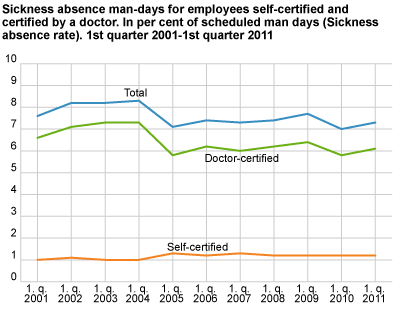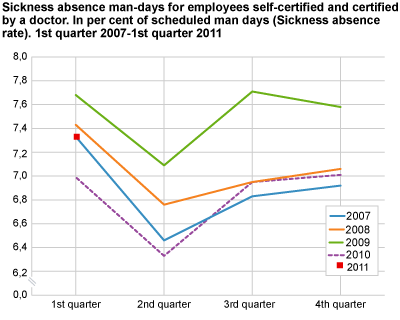Content
Published:
This is an archived release.
Increase in doctor-certified sickness absence
Sickness absence increased from 7 to 7.3 per cent from the first quarter of 2011 to the first quarter of 2011; an increase of 4.9 per cent.
Doctor-certified sickness absence rose from 5.8 to 6.1 per cent; an increase of 5.6 per cent. Self-certified sickness remained unchanged at 1.2 per cent.
A part of the increase may be due to the fact there were fewer cases of seasonal influenza in the first quarter of 2010 than in the first quarter of 2011.
Sickness absence in the first quarter of 2011 was 3.4 per cent lower than in the first quarter of 2001, the first year of implementation of the agreement on an inclusive labour market.
Strongest increase for women
Sickness absence for women increased from 8.7 to 9.3 per cent; an increase of 6.6 per, and for men it increased from 5.6 to 5.8 per cent. This represents an increase of 2.9 per cent.
Increase in most of the industries
The accommodation and food service and the administrative, support service activities industries were the only two industries with a fall in sickness absence from the first quarter of 2010 to the first quarter of 2011, with 5.1 and 1 per cent respectively. All of the other industries showed an increase. Public administration and education had the strongest increases, by 8.2 and 8.1 per cent respectively.
Increase in all sectors
Sickness absence rose in all of the sectors. Central government (including health enterprises) had the strongest increase by 8.4 per cent. Sickness absence in local government and the private sector increased by 7 and 3.5 per cent respectively.
Within central government, sickness absence in education (universities and university colleges) increased the most by 11.6 per cent, while public administration rose by 9.2 1 per cent. Health care activities (mainly health enterprises) rose by 8.6 per cent.
Within local government, there was a reduction in education (primary and secondary education) by 7.2 per cent, while the sickness absence in public administration rose by 7 per cent. Health care rose by 6.9 1 per cent.
The sickness absence level was lowest in the private sector, with 6.8 per cent, and highest in local government, with 9.2 per cent.
Increase for the age group 45-59 years
The female age groups 55-59 and 45-49 years had the strongest increase, by 13.3 and 10.2 per cent respectively.
For men, the age group 45-49 years had the strongest increase amongst the largest age groups by 6.2 per cent.
These results are based on data on sickness absence certified by a doctor, as the survey on self-certified absence does not contain data on sickness absence by age.
Sickness absence by new industry classification dating back to the year 2000From the figures published for the first quarter of 2009, a new industry classification is in use. These will give a break in the time series for the figures by industry. Statistics Norway has calculated figures according to the new industry classification dating back to the year 2000. We refer to tables 3 and 33 under “ More tables ”. Sickness absence according to the Labour Force Survey dating back to the year 1972The sickness absence statistics give figures dating back to the second quarter of 2000. For longer time series we must use other data sources, for instance the Labour Force Survey (LFS). Tables for sickness absence according to LFS dating back to 1972 (total figures) and 1979 (men/women) are now available in StatBank . |
Technical informationRates of change The sickness absence rates are presented using one decimal point. More decimal points are used when calculating the rates of change in order to get more accurate figures. These will therefore differ somewhat from the rates of change produced when using the published rounded figures. The statistics do not cover self-employed persons. |
| 1 Figure was corrected 20 September 2011. |
Tables:
- Table 1 Sickness absence man-days for employees self-certified and certified by a doctor. In per cent of scheduled man-days (Sickness absence rate). Quarterly figures. 2000-2011
- Table 2 Sickness absence man-days for employees self-certified and certified by a doctor, by sex. In per cent of scheduled man-days (Sickness absence rate). Quarterly figures. 2000-2011
- Table 28 Sickness absence by type of absence(self-certified or doctor-certified) and duration within the quarter
- Table 34 Cases of sickness absence and sickness absence man-days, self-certified and doctor-certified absence, by sex and duration. Per cent. Quarterly figures. 2010-2011
Tables
Contact
-
Arbeidsmarked og lønn
E-mail: arbeidsmarked@ssb.no
-
Unn H. Høydahl
E-mail: unnh.hoydahl@ssb.no
tel.: (+47) 40 90 23 77


